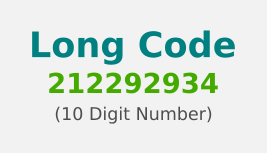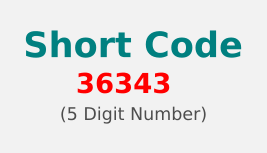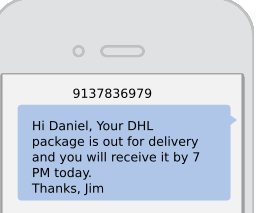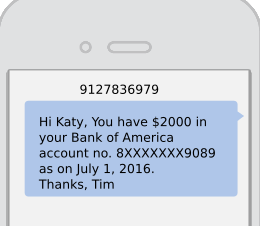While planning a text or SMS marketing campaign, one of the primary decisions an organization needs to make revolves around the selection of an inbound number. Inbound numbers, either in the form of long or shortcodes, are used to receive SMSs from leads and customers directly into an SMS application. This makes it easy for them to share feedback, ask questions and use these numbers for a variety of other use cases.
These virtual inbound numbers- long codes and shortcodes, act as the organization’s Sender ID (the from address in a text) and form the backbone of any texting or SMS marketing strategy.
Difference in Features
Difference 1: Changes in anatomy
As their names suggest, long codes form a longer set of digits as compared to shortcodes and can be used to send and receive texts, faxes and make calls. SMS long codes are 10 digit numbers and are tied to an area code, for e.g. (212) 221- 2929. These are typically used to send customers texts about their order dispatches, making it seem like the update is being received directly from the delivery boy.

SMS short codes, on the other hand, are 5-6 digits (look like ‘69488’ which Pizza Hut uses) and can only be used to send and receive SMSs, not faxes or calls.

Difference 2: Speed of sending/receiving SMSs
A major disadvantage with SMS long codes is related to the number of messages which can be sent per second. With a limit of one message per second, long codes are used primarily for person-to-person communication.

In contrast, SMS shortcodes can be used to send 40 messages per second and are typically used for high volume messaging like voting on TV shows.

Difference 3: Inbound to Outbound text ratio
According to carrier regulations, the ratio of inbound to outbound text traffic should be better than 1:3 for SMS long codes. There is no such restriction in place for shortcodes.
A point to keep in mind here is, carriers filter duplicate messages sent per minute from both long codes and shortcodes. A duplicate message is the one which has the same recipient, Sender ID, and message content.
If the same text content (like a marketing message) is going to multiple receivers from a long code, there is a high probability that the long code might get blocked by the carrier.
However, in the case of short code, predefined content for a text, approved by all the major carriers, can be sent to multiple people; irrespective of the quantity or sending frequency.
Difference in Use Cases
Typically, a long code is used by courier companies, banks, airlines and other service sectors for customer service related communication. Here are a few use cases-
•A courier company could use a long code to inform a customer that their package is out for delivery
•A bank could text clients their account balance every month
•An airline can reply to a passenger’s seat preference request

SMS short codes are most often used by companies for marketing and security or organizations for urgent information dissemination. short code are used for-
•Marketing promotions – To send ads, coupons, sales alerts and other promotional information. In fact, if you are based out of the US, it is mandatory to have a shortcode to send marketing texts
•Two-factor authentication – This is because a message sent via an SMS shortcode is likely to be delivered quicker
•Alert notifications like hurricane warnings or flight delays – Again due to the reliability aspect of short code

Comparing their Acquisition Process
Acquiring a long code for your business is easy – just fill up a form online or make a call and you can start texting within a day.
In contrast, getting a short code may take 6-8 weeks because it needs to be registered and the US Common Short Code Administration (CSCA) and carriers, both need to approve your application.
However, we at SMS-Magic always have pre-approved short code which can be implemented within a week or two, depending upon your use case and texting content.
Coverage
Long codes can be used globally, but don’t support delivery receipts, so a business won’t know for sure if the message has been received by the intended recipients unless they respond. However, with SMS-Magic, delivery status can be seen for long code as well. Overall, long codes are not considered to be very stable from a technical or legal standpoint.
On the other hand, short code are country-specific and provide delivery receipts, which are useful in cases like two-factor authentication, and when SMS delivery is critical. They are considered to be reliable in both aspects- technical & legal.
Which Code should you Use?
If a business is looking for a cheap, easy way to send and receive messages, mainly for support or conversational use and not for bulk messaging, with a low level of security- then it should choose long codes.
However, if you are looking to send SMSs mainly for marketing campaigns and willing to invest in a slightly expensive but robust, long-term SMS strategy, then short code are for you.
Get started with buying an inbound number here.